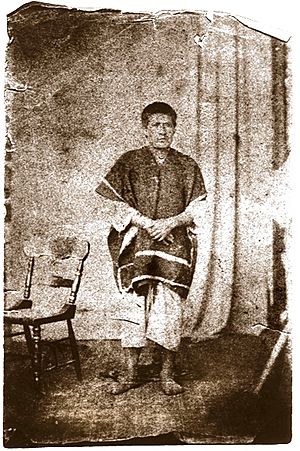Puruhá facts for kids
The Puruhá are an indigenous people who live in Ecuador. Their traditional home is in the high Andes Mountains. This area includes most of Chimborazo Province and parts of Bolívar Province.
Puruhá History and Culture
In the past, the Puruhá people grew their own food. They raised animals like guinea pigs. They also traded with the Inca before the Inca took over the Andean region in the 1400s.
When the Spanish arrived in the 1500s, there may have been as many as 155,000 Puruhá people. After the Spanish came, many Puruhá and Quechua people died. This was mainly because of new diseases brought by the Spanish. This caused big problems for their communities and led to more deaths.
By the 1700s, very few people still spoke the Puruhá language. Most indigenous people had started speaking Quechua languages. The Inca had brought Quechua when they took control in the 1400s. Leaders of the local Catholic Church also preferred that indigenous people speak Quechua. This was because some important Spanish people had married Inca people. The change in language made it harder for the Puruhá to keep their culture separate from the Quechua people.
Puruhá Rebellions
After the 1700s, the Puruhá sometimes rose up against their rulers. In 1871, indigenous people in Chimborazo Province rebelled. They were unhappy about taxes and forced labor. Many Puruhá joined this rebellion, which was led by Fernando Daquilema. The main fighting happened in the Riobamba Canton area.
During the rebellion, white and Mestizo people were forced to leave the town of Punín. The rebellion had some early successes. However, it eventually failed. Many Puruhá people were later forgiven by the government of Gabriel García Moreno. But a few leaders, including Daquilema, were executed. This rebellion is still an important part of the history for indigenous people in the province.
Puruhá Beliefs and Religion
The traditional religion of the Puruhá was led by jambiri. These were like medicine people or shamans. The people believed that their gods were connected to the mountains. The mountains were sacred and stood tall over the region. People would offer tobacco and rum to the gods. These were common offerings in other traditional Andean religions too.
Over time, many Puruhá people blended their traditional beliefs with Catholicism. This is called a syncretic faith. They combined their old ideas with how they understood and practiced Catholicism. The rich and powerful upper class, mostly European and Mestizo Ecuadorians, often made indigenous farmers feel unfairly treated, especially with money matters.
In the 1960s, Protestant Evangelicalism became more popular. Some people saw it as an alternative to Catholicism, which they felt supported the upper classes more. Evangelical missionaries were also seen as promoting a healthy lifestyle.
See also
 In Spanish: Puruhá para niños
In Spanish: Puruhá para niños


